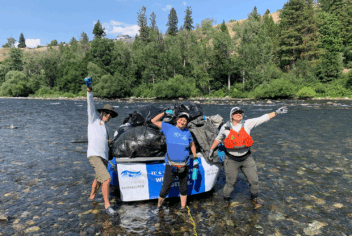As an insurance broker, your nonprofit clients are counting on your knowledge and expertise to help them through each step of their insurance journey, whether it’s finding the right insurance policy or helping them make a claim.
For a nonprofit, making a claim is already a stressful experience — it means something has gone awry in their organization. They will be looking for reassurance that their insurance coverage will be there for them, that their mission isn’t about to be derailed.
That’s where you come in.
In this article, insurance and claims experts from Nonprofits Insurance Alliance (NIA) share their experience on how brokers can help their nonprofit clients be ready for claims by ensuring they’ve got adequate coverage in place, guiding them through the claims process, and helping them be in the best position to get claims addressed as quickly and painlessly as possible.
Keep in touch with your clients.
If a nonprofit operates long enough, they will likely have to make a claim at some point. How well a nonprofit is prepared for that claim depends on strong — and frequent — communication with their broker.
Above all else, when it comes to insurance, the last thing nonprofits want is to find out that they don’t have coverage where they assumed they did, especially when they’re trying to make a claim.
To help them avoid this worst-case scenario, consider scheduling regular check-in meetings with your nonprofit clients to review their coverage.
“Follow up with your clients,” says Melissa Dalske, chief experience officer for NIA. “It’s a very basic thing, but it’s unbelievable how often it’s missed.”
Regular communication with your clients helps you stay informed about new programs, purchases, or other developments at the nonprofit — allowing you to identify potential coverage gaps these changes may have created and help the nonprofit address them before they can become a problem.
Dalske suggested that brokers should take the initiative and not wait for nonprofit clients to reach out.
“A lot of times a broker will find themselves in a bad spot when they haven’t checked in and the need for coverage has changed,” she explains.
“Any exposure changes matter, it all needs to be reported right away — in an ideal world, the nonprofit will reach out, but they are busy and may forget.”
When a claim happens.
When your nonprofit client calls you needing to make a claim with their insurance, this is your time to shine.
In a crisis situation where emotions may be running high, your job is to provide calm, logical instructions, and serve as a reassuring guide for your client as you help them along the steps to making a claim.
Here’s what you’ll want to do:
1. Be sure everyone is safe.
In an emergency, your nonprofit client’s first call should always be to 911.
When a nonprofit client calls you, the first thing you should do is check to make sure no one is in any immediate danger. If the situation is still dangerous, they should call 911 immediately and follow their emergency instructions until the danger has passed before contacting you.
“Make sure everyone at the facility is safe,” Dalske says. “Once the nonprofit makes sure their people are safe and their pets are safe, that’s when they should contact their broker.”
2. Notify the insurer quickly.
When a claim happens, time is of the essence. As soon as your nonprofit client reports a claim to you, your next step should be to alert the nonprofit’s insurance provider.
“I would encourage the broker to put the nonprofit in contact with us right away,” Dalske says. “We may have resources in-house that can help — it only hurts the nonprofit to hold off.”
The faster you’re able to bring the insurer on board, the faster that the insurer’s resources to address the claim can be activated and made available to the nonprofit.
“Talking to your clients about when to report a claim is very important,” says Keri Petersen, senior claims manager for NIA. “It’s important to provide notification early, so that we can analyze coverage and afford any protection possible to the nonprofit, including legal representation.”
3. Don’t make rash decisions.
When a situation arises that could necessitate an insurance claim — such as an emergency incident, potential lawsuits, or allegations of wrongdoing — making rash decisions without proper advice can come back to haunt your clients.
While your client’s first instinct may be to go public and make a statement in order to quickly “nip it in the bud,” such rash actions can introduce complications to defending the matter.
These types of public statements can attract unscrupulous people who may attempt to take advantage of the situation, they can be presented as evidence in a court case, and could even inadvertently close off legal avenues that could have otherwise been used in your client’s defense.
This is why you should involve the nonprofit’s insurance provider as soon as possible, as they can provide access to competent legal defense in the event of a covered claim — one of the main reasons nonprofits have insurance in the first place.
“Nonprofits are paying that premium so we can help them through that process.” Dalske says. “They should look to us for support.”
4. Document everything.
When your nonprofit client reports a claim, it’s important that they understand that every piece of information they provide could hold the key to successfully defending them in court against lawsuits and allegations of wrongdoing.
“Focus on providing prompt reporting of incidents and clear details,” says Petersen.
Dave Gibson, chief claims officer for NIA, explains that the more thorough information and more documented details they provide, the better. These can include police reports, daily logs, court documents, and more.
“You’d be surprised how little information we often get,” he says. “Give us all the relevant information and the right parties to contact.”
The point of contact, Gibson adds, is an often-overlooked part of the puzzle. Sometimes, the person who is normally a primary point of contact for an insurer is too closely involved to the claim, meaning a different point person at the nonprofit should be used.
“If there’s allegations of wrongdoing against a CEO,” he says, “they shouldn’t be the point of contact.”
5. Be proactive.
When your nonprofit client needs to make a claim, preparedness pays off.
“One of our strategies is proactivity,” Gibson says. “Sometimes, proactivity can be as simple as a conversation between the nonprofit and the broker to prepare and put a plan in place in the event of a claim.”
“The front-end work is that due diligence,” Dalske says. “It’s just keeping in communication: ‘How are you managing your risk?’ ‘How many clients are you serving?’”
During a claim, when the nonprofit begins supplying information to their insurer, there are online forms that must be submitted, providing relevant details about the situation surrounding the claim.
What can often happen, Gibson cautions, is that not all the information may be readily available when the nonprofit is working on the form — and the nonprofit won’t submit the documentation for days or weeks, assuming that only a completed form will be acceptable.
This, he says, can actually harm their claim, as the potential court proceedings will not wait for the nonprofit to complete their paperwork.
“We want nonprofits to be proactive,” Gibson explains, “it’s not helpful if we get a subpoena in and don’t have the information we need.”
The solution? Get the information you have entered as soon as possible — even if it’s not complete.
“We’ll take imperfect information on a large emergent thing and appreciate the heads-up.” Gibson says. “If there’s high stakes with media attention, we’ll take incomplete information to be prepared.”
6. Overlapping coverage with any other carriers?
Often, nonprofits have several different coverage policies — and not always with the same insurer.
Sometimes, Gibson says, the claim or lawsuit needs to be reviewed in conjunction with all available policies from any carriers due to the potential for overlapping coverage. Reporting to all carriers ensures that the client is fully and appropriately protected.
The best way brokers can help? Know those coverages inside and out.
“Brokers can best help their clients if they can understand the coverages offered,” says Gibson.
“If all the coverage is not with us,” he explains, “report it to the other insurance as well — and report to us that you’ve reported it to them.”
Conclusion
There are many ways that brokers can help your nonprofit clients be ready and prepared for the day a claim is necessary, and to support them when it happens.
As with so many things in life and business, strong communication is an essential element to success.
By establishing that rapport of trust and communication with your nonprofit clients, you’ll be able to better serve them in good times and bad as a reliable source of information and expertise that they know they can trust.





